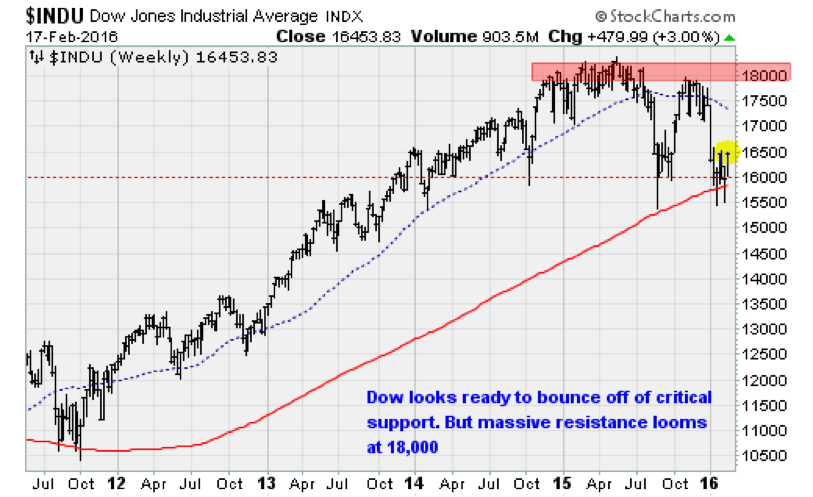Last Thursday, stocks peered into the darkness. The Dow Jones Industrial Average fell back to the 15,500 level -- a line in the sand that wasn’t crossed in August or again in January -- as a downturn to early 2013 levels looked likely.
But then, thanks to reports OPEC was finally working towards a production cut agreement, an epic short-squeeze materialized. Further impetus was provided by indications the Federal Reserve has been sufficiently frightened by recent market volatility and is set to delay any follow-up rate hike.
Related: Investing Guru: Trump and GOP Candidates Are Scaring the Markets
U.S. equities climbed more than 1% for the third-consecutive session on Wednesday, the first such winning streak since October 2011. And it was the Dow’s first-ever run of three straight gains of more than 200 points. By all indications the upswing should continue as market breadth, or the number of stocks participating to the upside, returns to levels not seen since October.
Still, there is massive resistance to Dow 18,000.

Three dynamics are in play.
The first is hopes of a production cut agreement by OPEC and Russia. Iranian oil minister Bijan Zanganeh met with officials from Qatar, Venezuela and Iraq in Tehran on Wednesday to discuss a proposal to freeze production at January levels. While Iran continues to demand that any agreement be based on pre-sanctions production levels, and no specifics have been agreed to just yet, merely the fact that a dialogue has been opened is seen as a hugely positive step towards addressing the deep oversupply problem.
Second, the release of the minutes of January’s Federal Reserve meeting highlighted uncertainty among officials about the consequences of recent financial market volatility, including the possible tightening of financial conditions, the risk to foreign economies and the drag on inflation.
The takeaway is that the Fed seems to be warming to the idea of a "wait-and-see" approach to allow the December rate hike -- the first since 2006 -- to be fully absorbed by capital markets and investors. The futures market currently doesn't expect another rate hike until early 2017.
The more the Fed aligns its own forecast with the market's (in December, it was looking for four 0.25% hikes this year), the more confident everyone will be that Fed Chair Janet Yellen isn't bungling the withdrawal from years of extreme policy stimulus.
Related: Here’s Why Interest Rates Could Be Locked In Until 2018
Third, the situation was primed for panicked short covering by market bears given deep oversold conditions, defensive positioning and bombed-out sentiment. In a note to clients, Goldman Sachs analysts noted that Tuesday was the largest short covering day since October 2014 in percentage terms. And over the past several days, this has been the largest short-squeeze since December 2008.
The tip of the spear on this front has been material stocks – steelmaking, mining and the like -- that have seen their share prices hit with a neutron bomb of a combination of global economic growth fears and the revenue drag from lower commodity prices.
Investors are set to enjoy a reprieve from the selling. A run at Dow 18,000 and beyond -- breaking a level of resistance going back to late 2014 -- will require a lot of things to go right.
Expectations are high for a European Central Bank policy meeting in March amid worries over bank earnings as long-term rates push below the zero boundary. The Bank of Japan is expected to call an emergency policy meeting after an interest rate cut destabilized the yen -- the opposite effect that was intended. OPEC needs to hammer out an agreement. And the Fed will meet again in March.
After miserable 4Q15 results, with the bulk of results in, the overall S&P 500 earnings growth rate stands at -3.7% -- the first time the index has seen three consecutive quarters of year-over-year declines in earnings since the first three quarters of 2009. And that caps a run of stalled profitability going back to the summer of 2014, which coincides with the peak in crude oil and the start of a bullish run in the U.S. dollar.
Related: Three Money Moves to Make When Stocks Are Sinking
As noted by Ed Yardeni at Yardeni Research, many big companies are responding to the drop in profitability by pulling back hard on capital expenditures -- factories, machinery and new hires -- which directly translate into lower GDP growth. Many in the energy sector are suffering layoffs as oil and gas wells are idled. Lower earnings translate into higher valuation multiples for equities.
It's no wonder that the economists at Wells Fargo just cut its 2016 U.S. GDP estimate from 2.5 percent to 2.1%.
Policymakers are finally responding to the market turmoil of the past seven months. But investors need to see results, including a resumption of corporate earnings growth, an increase in oil prices, a rebound in China's economy, a continuation of U.S. job creation and an increase in global inflation expectations.
Until that happens, treat this as a short-term rebound.
Anthony Mirhaydari is founder of the Edge and Edge Pro investment advisory newsletters. A two-week and four-week free trial offer has been extended to Fiscal Times readers.






